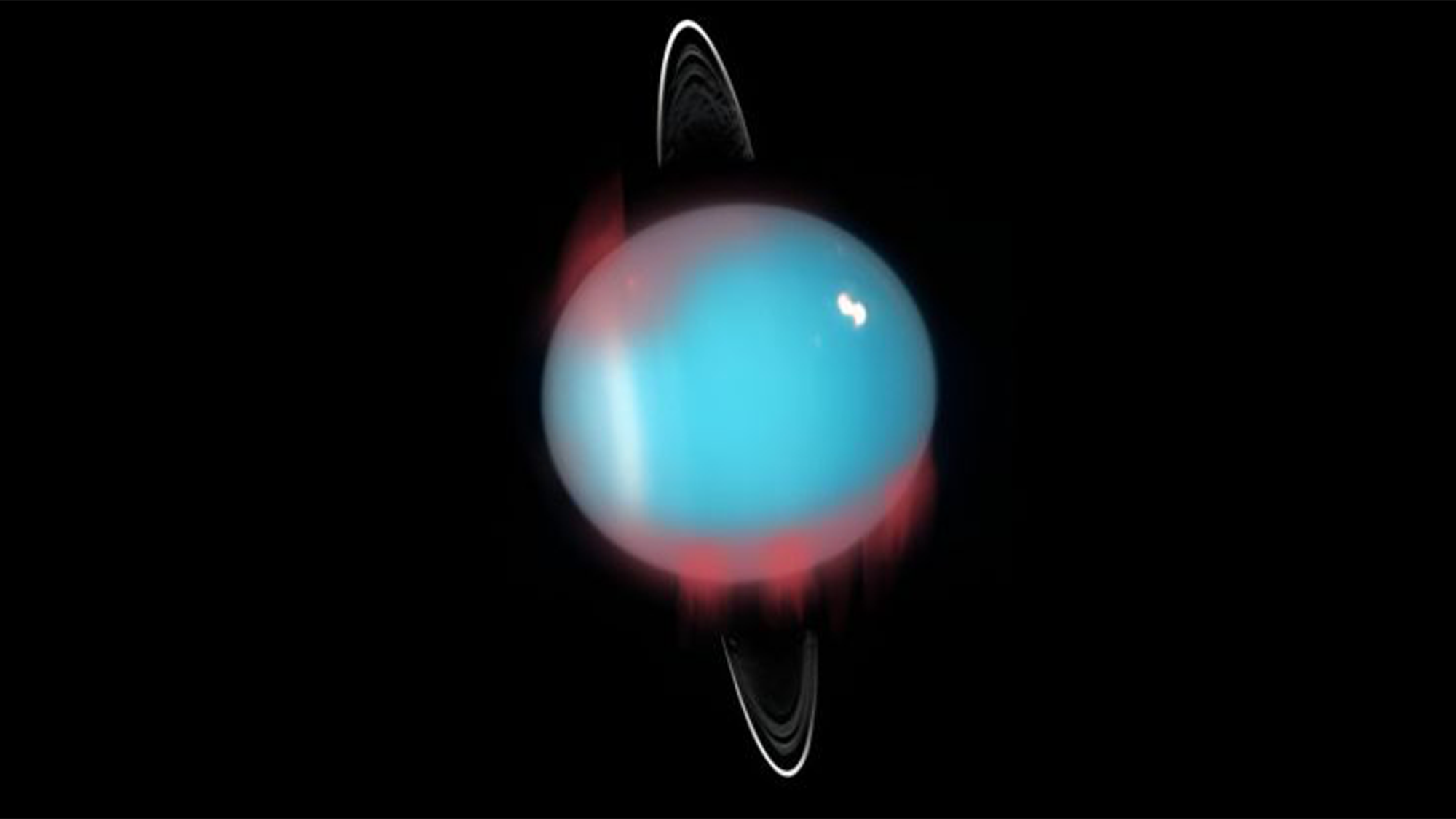

For the first time, astronomers using data from the Keck II telescope have detected the presence of an infrared aurora on the planet Uranus. The discovery could shed light on some of the unknown properties of the magnetic fields of our solar system’s planets. It could also help explain why a planet so far from the sun is hotter than it should be. The findings are described in a study published on October 23 in the journal Nature Astronomy.
[Related: Uranus got its name from a very serious authority.]
The NIRSPEC instrument (Near InfraRed SPECtrograph) at the Keck Observatory in Hawaii was used to collect 6 hours of observations of Uranus in 2006. The study’s authors carefully studied 224 images to find signs of a specific particle–ionized triatomic hydrogen or H3+. They found evidence of H3+ in the data after collisions with charged particles. The emission created an infrared auroral glow over Uranus’ northern magnetic pole. The image itself is an artist’s rendition of the infrared aurora, superimposed on a Hubble Space Telescope image of Uranus.
Uranian auroras vs. Earth auroras
Auroras on the planet Uranus are caused when charged particles from the sun interact with the planet’s magnetic field the same way they do on Earth. The particles are funneled along magnetic field lines toward the magnetic poles. When they enter the Uranian atmosphere, the charged particles bump into atmospheric molecules. This causes the molecules to glow.
The dominant gasses in Uranus’ atmosphere are hydrogen and helium and they are at much lower temperatures than on Earth. The presence of these gasses at these temperatures cause Uranus’ auroras to predominantly glow at ultraviolet and infrared wavelengths. By comparison, auroras on Earth come from oxygen and nitrogen atoms colliding with the charged particles and the colors are mostly blue, green, and red and can generally be seen with the human eye at the right latitudes.
Uranus and Neptune are unusual planets in our solar system because their magnetic fields are misaligned with the axes in which they spin. Astronomers haven’t found an explanation for this, but clues could lie in Uranus’s aurora.
Measuring the infrared
In the study, a team of astronomers used the first measurements of the infrared aurora at Uranus since investigations into the planet began in 1992. The ultraviolet aurorae of Uranus was first observed 1986, but the infrared aurora has not been observed until now, according to the team.
By analyzing specific wavelengths of light emitted from the planet. With this data, they can analyze the light called emission lines from these planets, which is similar to a barcode. In the infrared spectrum, the lines emitted by the H3+ particles will have different levels of brightness depending on how hot or cold the particle is and how dense this layer of the atmosphere is. The lines then act like a thermometer taking the planet’s temperature.
The astronomers found that there were distinct increases in H3+ density in Uranus’s atmosphere with little change in temperature. This is consistent with ionization that is caused by the presence of an infrared aurora. These measurements can help astronomers understand the magnetic fields on the other outer planets in the solar system. They could also scientists identify other planets that are suitable for supporting life.
[Related: Ice giant Uranus shows off its many rings in new JWST image.]
“The temperature of all the gas giant planets, including Uranus, are hundreds of degrees Kelvin/Celsius above what models predict if only warmed by the sun, leaving us with the big question of how these planets are so much hotter than expected? One theory suggests the energetic aurora is the cause of this, which generates and pushes heat from the aurora down towards the magnetic equator,” study co-author and University of Leicester PhD student Emma Thomas said in a statement.
Clues to life on exoplanets
According to Thomas, most of the exoplanets astronomers have discovered are in the sub-Neptune category, so they are a similar size as Neptune and Uranus. Similar magnetic and atmospheric characteristics could also exist on these exoplanets. Uranus’s aurora directly connects to the planet’s magnetic field and atmosphere, so studying it can help astronomers make predictions about the atmospheres and magnetic fields and their suitability for supporting life.
These results may also provide insight into a rare phenomenon on Earth called geomagnetic reversal. This occurs when the north and south poles switch hemisphere locations. According to NASA, pole reversals are pretty common in Earth’s geologic history and the last one occurred roughly 780,000 years ago. Paleomagnetic records show that over the last 83 million years, Earth’s magnetic poles have reversed 183 times. They’ve also reversed at least several hundred times in the past 160 million years. The time intervals between these reversals have fluctuated, but average about 300,000 years.
“We don’t have many studies on this phenomena and hence do not know what effects this will have on systems that rely on Earth’s magnetic field such as satellites, communications and navigation,” said Thomas. “However, this process occurs every day at Uranus due to the unique misalignment of the rotational and magnetic axes. Continued study of Uranus’s aurora will provide data on what we can expect when Earth exhibits a future pole reversal and what that will mean for its magnetic field.”
